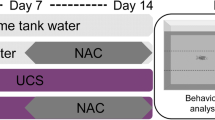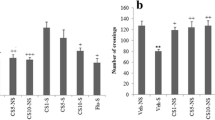Objectives. To study the neuroprotective properties of lithium ascorbate (LA) in in vivo and in vitro stress models. Materials and methods. Neurocytological and behavioral studies were run in models of stress in nerve cell cultures and experimental animals. Results. LA was shown to have a marked neuroprotective effect in conditions of glutamate-induced cytotoxicity in vitro and an adaptogenic effect on induction of stress in vivo. Conclusions. The results obtained here demonstrated that LA has high neuroprotective potential in stress induced in vivo and in vitro.
Similar content being viewed by others
References
G. Sel’e, Stress Without Distress, Progress, Moscow (1979).
B. S. Hemanth Kumar, S. K. Mishra, P. Rana, et al., “Neurodegenerative evidences during early onset of depression in CMS rats as detected by proton magnetic resonance spectroscopy at 7 T,” Behav. Brain Res., 232, No. 1, 53–59 (2012), doi: https://doi.org/10.1016/j.bbr.2012.03.011.
M. Cuadrado-Tejedor, A. Ricobaraza, J. Del Rio, et al., “Chronic mild stress in mice promotes cognitive impairment and CDK5-dependent tau hyperphosphorylation,” Behav. Brain Res., 220, No. 2, 338–343 (2011), doi: https://doi.org/10.1016/j.bbr.2011.01.005.
H. Qiao, S. C. An, W. Ren, and X. M. Ma, “Progressive alterations of hippocampal CA3-CA1 synapses in an animal model of depression,” Behav. Brain Res., 275, 191–200 (2014), doi: https://doi.org/10.1016/j.bbr.2014.08.040.
S. AbdAlla, A. El-Hakim, A. Abdelbaset, et al., “Inhibition of ACE retards tau hyperphosphorylation and signs of neuronal degeneration in aged rats subjected to chronic mild stress,” Biomed. Res. Int., 2015, 917156 (2015), doi.org/10.1155/2015/917156.
M. R. Hynd, H. L. Scott, and P. R. Dodd, “Glutamate-mediated excitotoxicity and neurodegeneration in Alzheimer’s disease,” Neurochem. Int., 45, No. 5, 583–595 (2004), doi.org/10.1016/j.neuint.2004.03.007.
M. S. Allagui, R. Nciri, M. F. Rouhaud, et al., “Long-term exposure to low lithium concentrations stimulates proliferation., modifies stress protein expression pattern and enhances resistance to oxidative stress in SH-SY5Y cells,” Neurochem. Res., 34, No. 3, 453–462 (2009), doi.org/10.1007/s11064-008-9804-8.
M. Sharifzadeh, M. Aghsami, S. Gholizadeh, et al., “Protective effects of chronic lithium treatment against spatial memory retention deficits induced by the protein kinase AII inhibitor H-89 in rats,” Pharmacology, 80, No. 2–3, 158–165 (2007), doi.org/10.1159/000103265.
G. J. Moore, J. M. Bebchuk, I. B. Wilds, et al., “Lithium-induced increase in human brain grey matter,” Lancet, 356, No. 9237, 1241–1242 (2000), doi.org/10.1016/s0140-6736(00)02793-8.
I. K. Lyoo, S. R. Dager, J. E. Kim, et al., “Lithium-induced gray matter volume increase as a neural correlate of treatment response in bipolar disorder: a longitudinal brain imaging study,” Neuropsychopharmacology, 35, No. 8, 1743–1750 (2010), doi.org/10.1038/npp.2010.41.
R. B. Sassi, M. Nicoletti, P. Brambilla, et al., “Increased gray matter volume in lithium-treated bipolar disorder patients,” Neurosci. Lett., 329, No. 2, 243–245 (2002), doi.org/10.1016/s0304-3940(02)00615-8.
N. A. Andreeva, E. V. Stel’mashuk, N. K. Isaev, et al., “The neuroprotective effects of the nootropic dipeptide GVS-111 in oxygen-glucose deprivation, glutamate toxicity, and oxidative stress in vitro,” Byull. Eksperim. Biol. Med., 130, No. 10, 18–421 (2000).
E. V. Stel’mashuk, S. V. Novikova, and N. K. Isaev, “Effects of glutamine on the death of cultured granule neurons induced by glucose deprivation and chemical hypoxia,” Biokhimiya, 75, No. 8, 1150–1156 (2010).
O. A. Gromova, I. Yu. Torshin, I. V. Gogoleva, et al., “Pharmacokinetic and pharmacodynamic synergism between neuropeptides and lithium in mediating the neurotrophic and neuroprotective actions of Cerebrolysin,” Zh. Nevrol. Psikhiatr., 115, No. 3, 65–72 (2015), doi: 10.17116/jnevro201511531.
V. V. Senatorov, M. Ren, H. Kanai, et al., “Short-term lithium treatment promotes neuronal survival and proliferation in rat striatum infused with quinolinic acid, an excitotoxic model of Huntington’s disease,” Mol. Psychiatry, 9, 371–385 (2004), doi.org/10.1038/sj.mp.4001463.
T. Dwivedi and H. Zhang, “Lithium-induced neuroprotection is associated with epigenetic modification of specific BDNF gene promoter and altered expression of apoptotic-regulatory proteins,” Front. Neurosci., 8, 457 (2015), doi.org/10.3389/fnins.2014.00457.
V. De-Paula, D. S. Kerr, M. P. F. De Carvalho, et al., “Long-term lithium treatment increases cPLA2 and iPLA2 activity in cultured cortical and hippocampal neurons,” Molecules, 20, 19878–19885 (2015), doi.org/10.3390/molecules201119663.
M. Emamghoreishi, M. Keshavarz, and A. A. Nekooeian, “Acute and chronic effects of lithium on BDNF and GDNF mRNA and protein levels in rat primary neuronal, astroglial and neuroastroglia cultures,” Iran. J. Basic Med. Sci., 18, 240–246 (2015).
R. Hashimoto, C. Hough, T. Nakazawa, et al., “Lithium protection against glutamate excitotoxicity in rat cerebral cortical neurons: involvement of NMDA receptor inhibition possibly by decreasing NR2B tyrosine phosphorylation,” J. Neurochem., 80, 589–597 (2002), doi.org/10.1046/j.0022-3042.2001.00728.x.
S. Nonaka, C. Hough, and D.-M. Chuang, “Chronic lithium treatment robustly protects neurons in the central nervous system against excitotoxicity by inhibiting N-methyl-D-aspartate receptor-mediated calcium influx,” Proc. Natl. Acad. Sci. USA, 95, 2642–2647 (1998), doi.org/10.1073/pnas.95.5.2642.
R. R. Leeds, F. Yu, Z. Wang, et al., “A new avenue for lithium: intervention in traumatic brain injury,” ACS Chem. Neurosci., 5, 422–433 (2014), doi.org/10.1021/cn500040g.
Author information
Authors and Affiliations
Corresponding author
Additional information
Translated from Zhurnal Nevrologii i Psikhiatrii imeni S. S. Korsakova, Vol. 116, No. 12, Iss. 1, pp. 86–91, December, 2016.
Rights and permissions
About this article
Cite this article
Pronin, A.V., Gromova, O.A., Sardaryan, I.S. et al. The Adaptogenic and Neuroprotective Properties of Lithium Ascorbate. Neurosci Behav Physi 48, 409–415 (2018). https://doi.org/10.1007/s11055-018-0579-3
Published:
Issue Date:
DOI: https://doi.org/10.1007/s11055-018-0579-3




